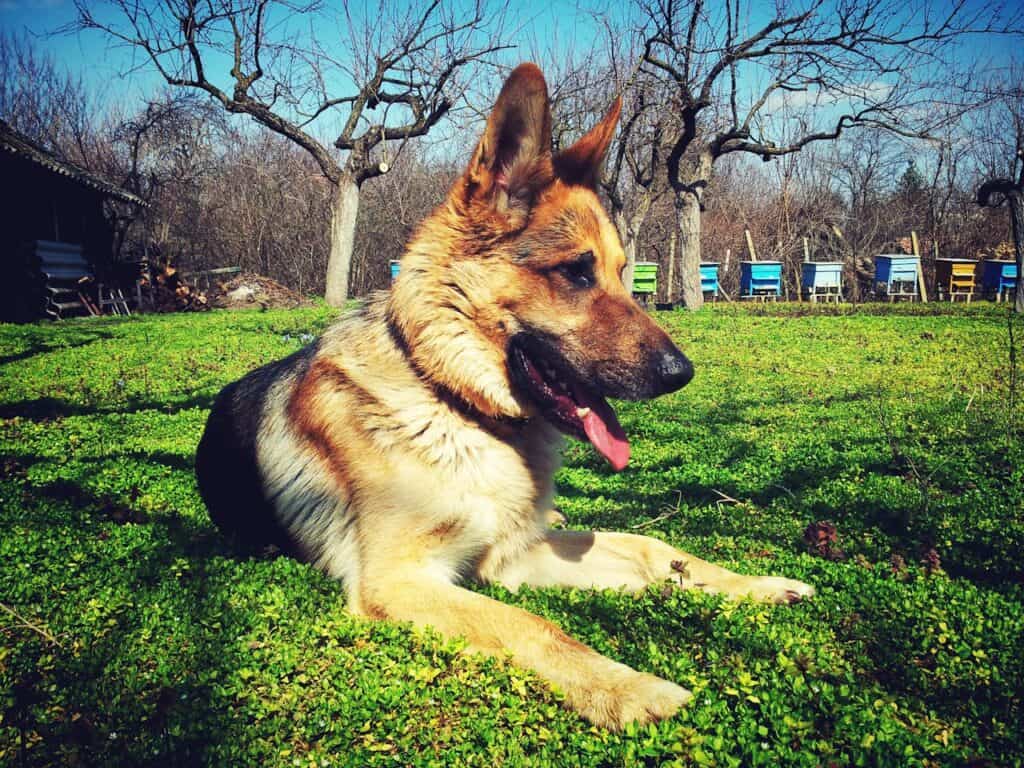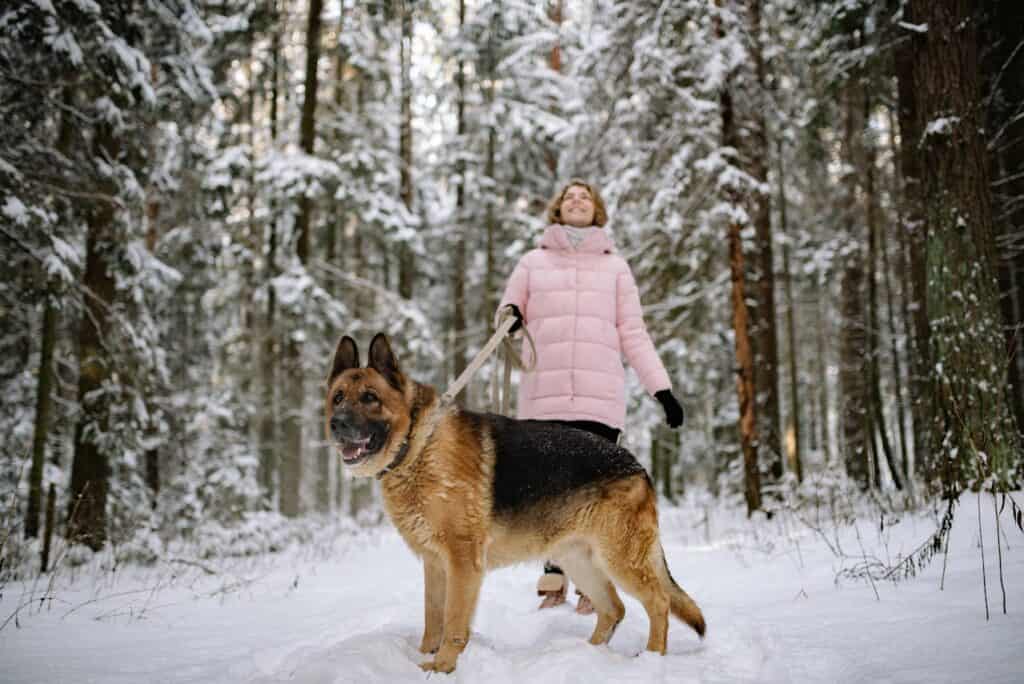1. Introduction
The German Shepherd, often recognized as one of the most versatile and loyal dog breeds, has a reputation that precedes it. Known for their intelligence, strength, and unwavering loyalty, these dogs have served in various roles, from police and military work to being cherished family pets. German Shepherds are often celebrated for their ability to adapt to various environments and tasks, making them a popular choice among dog enthusiasts and professionals alike. But what truly sets this breed apart is their distinctive blend of courage, confidence, and an instinct to protect, making them man’s best friend in every sense.
Key Characteristics and Traits
German Shepherds are medium to large-sized dogs, typically weighing between 50-90 pounds (23-41 kg) and standing 22-26 inches (56-66 cm) tall at the shoulder. Their appearance is commanding, with a strong, muscular build, erect ears, and a bushy tail that hangs down when at rest. They possess a double coat, which is dense and weather-resistant, adding to their rugged appeal. The most common color combinations are black and tan, though they can also be found in solid black, sable, or even white.
One of the most notable characteristics of the German Shepherd is their intelligence. Ranking among the top three most intelligent dog breeds, German Shepherds are quick learners and highly trainable. This intelligence, combined with their natural protective instincts, makes them excellent working dogs in various fields, from search and rescue operations to acting as guide dogs for the visually impaired.
2. Scientific Insights of the German Shepherd
Cognitive Abilities and Intelligence
German Shepherds are renowned for their cognitive abilities, which have been the subject of various studies over the years. In a landmark study by Dr. Stanley Coren, a professor of canine psychology, German Shepherds were ranked third in terms of working and obedience intelligence, just behind Border Collies and Poodles. This ranking is based on their ability to learn new commands quickly and their obedience to known commands at least 95% of the time.
Their intelligence extends beyond simple obedience; German Shepherds are known for their problem-solving abilities. A study published in the Journal of Veterinary Behavior highlighted the breed’s ability to solve complex tasks and adapt to new challenges, showcasing their impressive mental flexibility. This cognitive prowess is a key reason why they excel in roles that require quick thinking and adaptability, such as in police work or search and rescue missions.
Detection Skills and Olfactory Research
German Shepherds possess an extraordinary sense of smell, which has been scientifically documented in several research studies. Their olfactory bulbs, the part of the brain responsible for processing smells, are highly developed, allowing them to detect scents at incredibly low concentrations. According to research published in the Applied Animal Behaviour Science, German Shepherds have been trained to detect various substances, from explosives to narcotics, with remarkable accuracy.
In one study conducted by the University of Pennsylvania’s Working Dog Center, German Shepherds were trained to detect ovarian cancer in tissue samples. The results were astonishing, with the dogs identifying cancerous tissues with over 90% accuracy, demonstrating their potential in medical detection work. This olfactory capability, combined with their intelligence, makes them indispensable in detection roles.
Behavioral Genetics and Temperament
The temperament of the German Shepherd is deeply rooted in its genetics. Selective breeding has played a significant role in shaping the breed’s behavior, particularly its loyalty, protectiveness, and courage. Studies on canine behavioral genetics have shown that German Shepherds possess a higher degree of genetic predisposition towards traits such as confidence and a low threshold for aggression when it comes to protecting their family or handler.
Research conducted by the Max Planck Institute for Evolutionary Anthropology explored the genetic markers associated with the breed’s temperament. The study found that specific gene variants in German Shepherds are linked to behaviors such as loyalty and sociability, which are less pronounced in other breeds. This genetic makeup contributes to their role as reliable working dogs and loyal companions.
Role in Medical Therapy and Assistance
German Shepherds have also been the focus of studies in the field of medical therapy and assistance. Their intelligence, coupled with their strong bond with humans, makes them ideal candidates for therapy work. A study published in the Journal of Psychiatric Research examined the impact of German Shepherds on individuals with PTSD (Post-Traumatic Stress Disorder). The study found that patients who interacted with German Shepherds experienced significant reductions in anxiety and depressive symptoms, highlighting the breed’s therapeutic potential.
Moreover, German Shepherds have been extensively used as guide dogs for the visually impaired. Their ability to learn complex tasks, combined with their stable temperament, ensures they can navigate challenging environments while keeping their handler safe. This role in assistance work further underscores the breed’s adaptability and intelligence.
3. History and Origin
Origin of the German Shepherd
The German Shepherd’s origins can be traced back to late 19th-century Germany, where Captain Max von Stephanitz, a former cavalry officer, sought to create the ultimate working dog. Von Stephanitz was inspired by the various sheepdogs found across Germany, which exhibited traits such as intelligence, strength, and a strong work ethic. By selectively breeding these dogs, von Stephanitz aimed to develop a breed that excelled in herding but was also versatile enough for other types of work.
In 1899, von Stephanitz acquired a dog named Horand von Grafrath, who would become the first registered German Shepherd. Horand embodied the traits von Stephanitz desired: intelligence, loyalty, and physical prowess. This dog became the foundation of the breed, and through careful breeding, von Stephanitz established the German Shepherd as a working dog par excellence.
Historical Roles and Significance
The German Shepherd quickly gained popularity not only as a herding dog but also in roles that required courage and intelligence. During World War I, German Shepherds were used by the German military for various tasks, including delivering messages, detecting mines, and acting as sentries. Their performance during the war showcased their versatility and solidified their reputation as reliable working dogs.
After the war, German Shepherds gained international recognition, particularly in the United States, where returning soldiers spoke highly of the breed. This led to an increase in popularity, and the breed was soon adopted by police and military forces worldwide. Today, German Shepherds continue to serve in various capacities, from law enforcement to search and rescue, thanks to their strong work ethic and adaptability.

4. Physical Characteristics
Size and Weight of the German Shepherd
German Shepherds are a well-proportioned and muscular breed, with males typically weighing between 65-90 pounds (29-41 kg) and females weighing 50-70 pounds (23-32 kg). They stand 24-26 inches (61-66 cm) tall at the shoulder for males and 22-24 inches (56-61 cm) for females. Their size and weight make them formidable yet agile dogs, capable of performing a wide range of tasks.
Coat Type and Color
The German Shepherd’s coat is one of its most distinctive features. They have a double coat consisting of a dense, water-resistant outer layer and a softer undercoat. This double coat provides protection against harsh weather conditions, making them well-suited for outdoor work. The most common coat colors are black and tan, but German Shepherds can also come in solid black, sable, or even white.
Distinctive Features
In addition to their striking coat, German Shepherds have several distinctive features that set them apart from other breeds. Their ears are large and erect, giving them an alert and intelligent expression. Their eyes are medium-sized and dark, exuding confidence and warmth. The German Shepherd’s tail is bushy and hangs down when the dog is relaxed, but it may be carried higher when the dog is excited or on alert.
Another distinctive feature is their strong, muscular build, which contributes to their endurance and speed. German Shepherds are known for their powerful stride, which allows them to cover ground quickly and efficiently.
Speed and Agility
Despite their size, German Shepherds are remarkably agile. They can reach speeds of up to 30 miles per hour (48 km per hour) when sprinting, making them one of the faster dog breeds. This speed, combined with their agility, makes them excellent candidates for roles that require quick reflexes and precision, such as search and rescue or competitive sports like agility trials.
Their agility is not limited to speed; German Shepherds are also known for their ability to navigate challenging terrain with ease. This makes them valuable in search and rescue operations, where they may need to traverse rough landscapes to locate missing persons.
5. Types of German Shepherds
Working Line vs. Show Line
German Shepherds can be broadly categorized into two types: working line and show line. The working line German Shepherds are bred primarily for their abilities as working dogs. They tend to have a more compact and muscular build, with a focus on endurance, strength, and agility. These dogs are often used in police work, search and rescue, and other demanding roles that require a high level of physical and mental stamina.
Show line German Shepherds, on the other hand, are bred for their appearance and are typically seen in dog shows. They tend to have a more sloped back and are often larger than their working line counterparts. While they still retain the intelligence and trainability of the breed, show line German Shepherds are more commonly found as family pets or in less physically demanding roles.
American vs. European German Shepherds
Another distinction within the breed is between American and European German Shepherds. American German Shepherds tend to have a more exaggerated sloped back and are often bred with a focus on appearance rather than working ability. European German Shepherds, particularly
those from Germany, are bred with a stronger emphasis on working traits, including temperament, drive, and physical ability.
European German Shepherds are often used in professional roles, such as law enforcement or search and rescue, while American German Shepherds are more commonly seen in show rings or as companion animals.
6. Temperament and Personality
General Behavior and Traits of the German Shepherd
The German Shepherd is known for its loyal and protective nature. They are incredibly devoted to their families and will go to great lengths to protect them. This loyalty, combined with their intelligence, makes them excellent guard dogs. However, they are not naturally aggressive; German Shepherds are calm and composed, reacting with measured responses to perceived threats.
They are also highly sociable dogs, especially when properly socialized from a young age. German Shepherds form strong bonds with their families and thrive on companionship. They are known for their confidence and courage, never backing down from a challenge but always approaching situations with a calm demeanor.
Interaction with Family, Children, and Other Pets
German Shepherds are known for their strong bonds with their families, including children. They are protective yet gentle, making them excellent family pets. However, due to their size and strength, it is essential to supervise interactions between German Shepherds and small children to ensure safety. Proper training and socialization can help German Shepherds become patient and tolerant, making them trustworthy companions for kids.
When it comes to other pets, German Shepherds can get along well with other dogs and even cats, provided they are introduced properly and socialized from a young age. Their natural instincts may lead them to be dominant, so early socialization is crucial to ensure harmonious relationships with other animals in the household.
Socialization Needs
Socialization is critical for German Shepherds, as it helps them develop into well-rounded and confident adults. Exposing them to various people, environments, and other animals from a young age will ensure they grow up to be adaptable and well-behaved dogs. German Shepherds that are not properly socialized may become overly protective or anxious, leading to behavioral issues.
Socialization should be a continuous process throughout the dog’s life, with regular exposure to new experiences. This will help them remain confident and composed in various situations, whether at home, in public, or in new environments.
7. Health and Common Diseases
Typical Lifespan of the German Shepherd
German Shepherds have a typical lifespan of 9-13 years, which is relatively average for a breed of their size. However, their lifespan can be influenced by factors such as genetics, diet, exercise, and access to regular veterinary care. With proper care and attention, many German Shepherds can live well into their teens.
Common Health Issues and Genetic Conditions
Like all breeds, German Shepherds are prone to specific health issues, some of which are hereditary. One of the most common genetic conditions affecting German Shepherds is hip dysplasia, a malformation of the hip joint that can lead to arthritis and mobility issues. This condition can be managed with proper care, but it is crucial to obtain a German Shepherd from a reputable breeder who tests for hip dysplasia in their breeding stock.
Another common issue is elbow dysplasia, which affects the elbow joints and can cause pain and lameness. Degenerative myelopathy, a progressive neurological disorder that affects the spinal cord, is also prevalent in German Shepherds and leads to gradual paralysis.
German Shepherds are also prone to bloat, a life-threatening condition where the stomach twists and traps gas, leading to a sudden increase in pressure. This requires immediate veterinary intervention. Regular check-ups and a balanced diet can help manage and prevent some of these health issues.
8. Care and Grooming
Grooming Needs of the German Shepherd
German Shepherds have moderate grooming needs due to their double coat. They shed year-round, with more intense shedding during seasonal changes in spring and fall. Regular brushing, ideally several times a week, is necessary to remove loose hair and prevent matting. During shedding seasons, daily brushing may be required to manage the amount of hair.
Bathing should be done as needed, typically every few months, unless the dog gets particularly dirty. Over-bathing can strip the coat of its natural oils, leading to dry skin. Regular ear cleaning, teeth brushing, and nail trimming are also essential parts of a German Shepherd’s grooming routine.
Exercise Requirements
German Shepherds are an active breed that requires regular exercise to maintain their physical and mental health. They need at least 1-2 hours of exercise daily, which can include walks, playtime, and mental stimulation activities. Due to their intelligence, they also thrive on tasks that challenge their minds, such as obedience training, agility courses, or puzzle toys.
Exercise is not just about physical activity; it also helps prevent boredom, which can lead to destructive behaviors. German Shepherds that do not receive enough exercise may become anxious, frustrated, or develop behavioral problems. Providing them with adequate physical and mental stimulation is essential for a happy and well-balanced dog.
9. Hypoallergenic Status
German Shepherds are not considered hypoallergenic. Their shedding, particularly during seasonal changes, can trigger allergies in sensitive individuals. The dander (dead skin cells) they produce is a common allergen. While regular grooming can help manage shedding and reduce dander, it will not eliminate allergens entirely.
If you or a family member suffers from dog allergies, it is essential to spend time around German Shepherds before bringing one into your home to ensure that the breed does not cause significant allergic reactions.

10. Nutrition Requirements
Dietary Needs of the German Shepherd
The dietary needs of a German Shepherd will vary based on their age, activity level, and health. Generally, they require a high-quality, balanced diet that provides all the essential nutrients. Protein is particularly important for this breed, given their muscular build and high energy levels. Look for dog food that lists meat as the first ingredient and avoid foods with excessive fillers.
For puppies, a diet formulated for large-breed puppies is recommended, as it helps support their rapid growth without causing joint issues. Adult German Shepherds should be fed a diet that maintains their weight and meets their energy needs, while senior German Shepherds may benefit from a diet that supports joint health and mobility.
Recommended Food and Supplements
In addition to high-quality dog food, some German Shepherds may benefit from supplements. Glucosamine and chondroitin are commonly recommended for joint health, particularly in breeds prone to hip and elbow dysplasia. Omega-3 fatty acids, found in fish oil, can help maintain a healthy coat and skin, as well as support cognitive function.
Always consult with a veterinarian before introducing supplements to ensure they are appropriate for your dog’s specific needs. Fresh water should always be available, and treats should be given in moderation to prevent obesity.
11. Training and Obedience
Trainability of the German Shepherd
German Shepherds are highly trainable due to their intelligence and eagerness to please. They excel in obedience training and can learn complex commands and tasks with relative ease. Early training is essential to ensure they develop into well-mannered adults, and their training should be consistent and positive.
Positive reinforcement techniques, such as using treats, praise, and play, are particularly effective with German Shepherds. They respond well to clear and consistent commands and thrive in an environment where they are mentally stimulated and challenged.
Common Training Techniques
Training should begin with basic commands such as sit, stay, come, and heel. Once these are mastered, more advanced training can be introduced, including agility, tracking, or protection work, depending on the dog’s role. German Shepherds also benefit from socialization training, where they learn to interact with various people, animals, and environments.
Crate training is often recommended for German Shepherds, as it provides them with a safe space and can help with housebreaking. Leash training is also important, as German Shepherds are strong dogs that need to be taught to walk calmly on a leash.
Tips for Successful Training
Consistency is key when training a German Shepherd. Training sessions should be short but frequent, keeping the dog engaged and preventing boredom. Patience and positive reinforcement will yield the best results, as harsh methods can lead to fear or anxiety in the dog.
It’s also important to make training a part of daily life. Incorporate commands into regular activities, such as having the dog sit before meals or stay before going for a walk. This helps reinforce training and ensures the dog remains obedient in various situations.
12. Work and Activities
Activities or Jobs That the German Shepherd Excels In
German Shepherds are incredibly versatile and excel in a wide range of activities and jobs. They are commonly used in police and military work, where their intelligence, strength, and loyalty make them ideal for tasks such as tracking, apprehension, and detection. Their keen sense of smell also makes them valuable in search and rescue missions, where they can locate missing persons in challenging environments.
In addition to professional work, German Shepherds excel in various dog sports, such as agility, obedience, and herding trials. These activities provide both physical exercise and mental stimulation, helping to keep the dog healthy and happy.
Examples of Competitive Sports, Therapy Work, and Search and Rescue
German Shepherds are frequent competitors in agility trials, where their speed and agility are on full display. They navigate obstacle courses with precision and speed, showcasing their physical prowess and trainability. Obedience trials are another area where German Shepherds shine, as they demonstrate their ability to follow complex commands with accuracy.
In therapy work, German Shepherds provide comfort and support to individuals in hospitals, nursing homes, and rehabilitation centers. Their calm demeanor and strong bond with humans make them effective therapy dogs, helping to improve the emotional well-being of those they visit.
In search and rescue, German Shepherds are trained to locate missing persons in a variety of environments, from urban areas to wilderness. Their speed, agility, and keen sense
of smell make them invaluable in these missions, often saving lives in the process.
13. Behavioral Issues
Common Behavioral Issues
While German Shepherds are generally well-behaved and obedient, they can develop behavioral issues if not properly trained or socialized. One common issue is separation anxiety, which can occur if the dog becomes too attached to their owner and is left alone for extended periods. This can lead to destructive behaviors, such as chewing or excessive barking.
Another issue is aggression, which can manifest if the dog is not properly socialized or feels threatened. German Shepherds are protective by nature, and if not trained to discern between real and perceived threats, they may become overly aggressive towards strangers or other animals.
Managing and Correcting Behavioral Problems
Addressing behavioral issues in German Shepherds requires patience and consistency. For separation anxiety, providing the dog with mental stimulation, such as puzzle toys or interactive games, can help alleviate boredom and anxiety. Gradual desensitization to being alone, combined with positive reinforcement, can also help reduce anxiety.
Aggression can be managed through proper socialization and training. Introducing the dog to various people, animals, and environments from a young age will help them learn to interact appropriately. If aggression becomes a significant issue, working with a professional dog trainer or behaviorist may be necessary to correct the behavior.
Regular exercise and mental stimulation are also crucial in preventing and managing behavioral issues. A well-exercised and mentally challenged German Shepherd is less likely to develop negative behaviors.
14. Ideal Owners and Families
Type of Owners Best Suited for the German Shepherd
German Shepherds are best suited for owners who lead active lifestyles and have the time and energy to dedicate to their dog’s training and exercise needs. They require a strong, confident owner who can provide consistent leadership and guidance. First-time dog owners may find the breed challenging due to their intelligence and energy levels, so experience with dogs is often beneficial.
Compatibility with Families, Singles, Older People, etc.
German Shepherds are highly adaptable and can thrive in various living situations, whether with families, singles, or older people. They are particularly well-suited for families with children, as they are protective yet gentle. However, their size and strength mean they may not be the best choice for households with very young children or elderly individuals unless proper supervision and training are in place.
For singles or older people, German Shepherds can be excellent companions, provided they receive adequate exercise and mental stimulation. They are loyal and devoted dogs that form strong bonds with their owners, making them excellent companions for those who can meet their needs.
Living Conditions
German Shepherds can adapt to various living conditions, from apartments to homes with large yards. However, they require regular exercise and mental stimulation, so access to outdoor space or daily walks is essential. They are not well-suited to being left alone for long periods, as they thrive on companionship and interaction with their owners.
In homes with yards, it is important to have secure fencing, as German Shepherds are strong and agile and may try to escape if bored or anxious. They can adapt to indoor living, but regular outdoor activity is crucial to prevent boredom and associated behavioral issues.
15. Adaptability
Adaptability to Different Environments
German Shepherds are highly adaptable dogs that can thrive in various environments, from rural areas to urban settings. Their intelligence and trainability make them capable of adjusting to new situations and environments with relative ease. However, they require regular mental and physical stimulation to prevent boredom and ensure their well-being.
In urban environments, German Shepherds may need more structured exercise routines, such as daily walks or visits to dog parks, to ensure they remain physically active. In rural areas, they may have more opportunities for free play and exploration, which can help satisfy their need for exercise and mental engagement.
Adjustments to Lifestyle Changes
German Shepherds can adjust to lifestyle changes, such as moving to a new home or the arrival of a new family member, as long as their basic needs for exercise, mental stimulation, and companionship are met. Introducing changes gradually and maintaining a consistent routine can help ease the transition and prevent stress or anxiety in the dog.
Their adaptability also extends to changes in their role within the family, such as shifting from a working dog to a family companion. With proper training and socialization, German Shepherds can successfully navigate these transitions and continue to thrive in their new roles.

16. Famous German Shepherds
Notable German Shepherds in History, Movies, or Public Life
German Shepherds have been celebrated in various roles, from working dogs to movie stars. One of the most famous German Shepherds in history is Rin Tin Tin, a dog rescued from a World War I battlefield who went on to become a Hollywood star. Rin Tin Tin appeared in numerous films in the 1920s and 1930s, helping to popularize the breed in the United States.
Another famous German Shepherd is Strongheart, one of the first canine stars of American cinema. Strongheart appeared in several silent films in the 1920s and was known for his heroic and intelligent portrayal of the breed.
In more recent history, German Shepherds have continued to serve in various public roles, from police and military work to therapy and assistance. Their versatility and loyalty have made them enduring symbols of courage and service.
17. Summary
Summary of Key Points
The German Shepherd is a versatile and loyal breed known for its intelligence, strength, and adaptability. Originating in Germany in the late 19th century, the breed was developed for herding but quickly gained recognition for its ability to excel in various roles, from police and military work to family companionship. German Shepherds are medium to large-sized dogs with a distinctive double coat and erect ears, and they possess remarkable cognitive abilities and a strong work ethic.
German Shepherds require regular exercise, mental stimulation, and socialization to thrive. They are highly trainable and excel in various activities, from obedience and agility to search and rescue. While they are prone to certain health issues, such as hip dysplasia and bloat, proper care and attention can help them live healthy, fulfilling lives.
Whether as working dogs or beloved family pets, German Shepherds have earned their place as one of the most popular and respected dog breeds in the world. Their loyalty, intelligence, and versatility make them a truly exceptional breed.
This article is brought to you by Our World of Dogs. Explore more dog breeds and find out how our dog boarding services can benefit your furry friend!



